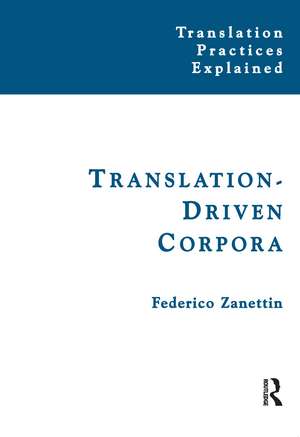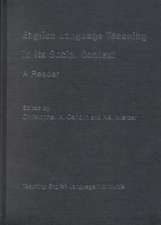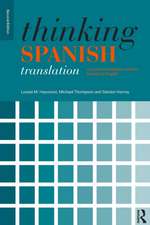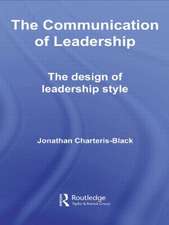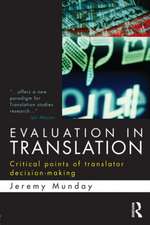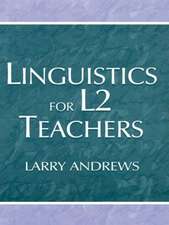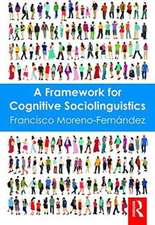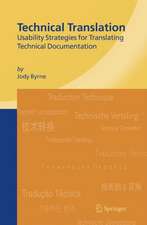Translation-Driven Corpora: Corpus Resources for Descriptive and Applied Translation Studies: Translation Practices Explained
Autor Federico Zanettinen Limba Engleză Paperback – 10 ian 2012
Corpus creation and use are illustrated through practical examples and case studies, with each chapter outlining a set of tasks aimed at guiding researchers, students and translators to practice some of the methods and use some of the resources discussed. These tasks are meant as hands-on activities to be carried out using the materials and links available in accompanying downloadable resources. Suggested further readings at the end of each chapter are complemented by an extensive bibliography at the end of the volume.
Translation-Driven Corpora is designed for use by teachers and students in the classroom or by researchers and professionals for self-learning. It is an invaluable resource for anyone interested in this fast growing area of scholarly and professional activity.
| Toate formatele și edițiile | Preț | Express |
|---|---|---|
| Paperback (1) | 443.69 lei 6-8 săpt. | |
| Taylor & Francis – 10 ian 2012 | 443.69 lei 6-8 săpt. | |
| Hardback (1) | 767.47 lei 6-8 săpt. | |
| Taylor & Francis – feb 2016 | 767.47 lei 6-8 săpt. |
Din seria Translation Practices Explained
-
 Preț: 303.89 lei
Preț: 303.89 lei -
 Preț: 302.17 lei
Preț: 302.17 lei -
 Preț: 265.72 lei
Preț: 265.72 lei -
 Preț: 233.92 lei
Preț: 233.92 lei -
 Preț: 280.81 lei
Preț: 280.81 lei -
 Preț: 287.68 lei
Preț: 287.68 lei -
 Preț: 309.50 lei
Preț: 309.50 lei -
 Preț: 228.76 lei
Preț: 228.76 lei -
 Preț: 289.62 lei
Preț: 289.62 lei -
 Preț: 346.96 lei
Preț: 346.96 lei - 18%
 Preț: 1058.65 lei
Preț: 1058.65 lei -
 Preț: 287.05 lei
Preț: 287.05 lei -
 Preț: 259.40 lei
Preț: 259.40 lei -
 Preț: 349.91 lei
Preț: 349.91 lei - 17%
 Preț: 271.43 lei
Preț: 271.43 lei -
 Preț: 279.69 lei
Preț: 279.69 lei -
 Preț: 465.91 lei
Preț: 465.91 lei - 5%
 Preț: 323.59 lei
Preț: 323.59 lei -
 Preț: 290.37 lei
Preț: 290.37 lei -
 Preț: 410.50 lei
Preț: 410.50 lei -
 Preț: 380.36 lei
Preț: 380.36 lei -
 Preț: 362.82 lei
Preț: 362.82 lei - 17%
 Preț: 246.74 lei
Preț: 246.74 lei - 17%
 Preț: 246.96 lei
Preț: 246.96 lei - 22%
 Preț: 371.87 lei
Preț: 371.87 lei - 13%
 Preț: 321.08 lei
Preț: 321.08 lei -
 Preț: 367.23 lei
Preț: 367.23 lei -
 Preț: 395.85 lei
Preț: 395.85 lei
Preț: 443.69 lei
Nou
Puncte Express: 666
Preț estimativ în valută:
84.93€ • 92.28$ • 71.38£
84.93€ • 92.28$ • 71.38£
Carte tipărită la comandă
Livrare economică 21 aprilie-05 mai
Preluare comenzi: 021 569.72.76
Specificații
ISBN-13: 9781905763290
ISBN-10: 1905763298
Pagini: 258
Dimensiuni: 174 x 246 x 13 mm
Greutate: 0.32 kg
Ediția:1
Editura: Taylor & Francis
Colecția Routledge
Seria Translation Practices Explained
Locul publicării:Oxford, United Kingdom
ISBN-10: 1905763298
Pagini: 258
Dimensiuni: 174 x 246 x 13 mm
Greutate: 0.32 kg
Ediția:1
Editura: Taylor & Francis
Colecția Routledge
Seria Translation Practices Explained
Locul publicării:Oxford, United Kingdom
Public țintă
Postgraduate and ProfessionalCuprins
1. Introduction
1.1 Book outline
1.2 How to use the DVD
2. Corpus linguistics and translation studies
2.1 A typology of translation-driven corpora
2.2 Corpus-based translation research
2.2.1 Regularities of translations
2.2.1.1 Simplification
2.2.1.2 Explicitation
2.2.1.3 Standardization
2.2.1.4 Translation of unique items
2.2.1.5 Untypical collocations
2.2.1.6 Interference
2.2.2 Regularities of translators
2.2.3 Regularities of languages
2.2.4 Learner translation corpora
2.2.5 Interpreting and multimodal corpora
2.3 Corpus-based translation teaching and learning
2.4 Computer-assisted translation and computational linguistics
2.5 Tasks
2.5.1 Experimenting with the TEC
2.5.2 Experimenting with COMPARA
2.5.3 Experimenting with the LTC
2.6 Further reading
3. Corpus design and acquisition
3.1 Corpus design
3.1.1 Size
3.1.2 Composition
3.1.3 Representativeness and comparability
3.1.4 Case study: the CEXI corpus
3.2 Corpus acquisition and copyright
3.3 Web corpora
3.3.1 The Web as corpus
3.3.2 The Web as a source of corpora
3.3.2.1 General Web corpora
3.3.2.2 Specialized Web corpora
3.4 Conclusions
3.5 Tasks
3.5.1 Corpus building project outline
3.5.2 Manual creation of a DIY monolingual corpus
3.5.3 Automatic creation of a DIY bilingual comparable corpus
3.6 Further reading
4. Corpus encoding and annotation
4.1 Corpus-based translation studies and corpus annotation
4.2 Annotation for descriptive translation studies
4.2.1 Documentary information
4.2.2 Structural information
4.2.3 Text-linguistic information
4.3 Stand-off annotation
4.4 Conclusions
4.5 Tasks
4.5.1 Creating an XML TEI document
4.5.2 Adding a simple header
4.5.3 Marking-up text structure
4.5.4 Adding linguistic annotation
4.5.5 Indexing the corpus
4.5.6 Searching the corpus
4.6 Further reading
5. Corpus tools and corpus analysis
5.1 Corpus creation and analysis tools
5.1.1 Text acquisition
5.1.2 Annotation
5.1.3 Corpus management and query systems
5.1.4 Data retrieval and display
5.2 Analysis of corpus data
5.2.1 Wordlists and basic statistics
5.2.2 Concordances
5.2.3 Collocations, clusters and clouds
5.2.4 Colligations and word profiles
5.2.5 Semantic associations
5.3 Conclusions
5.4 Tasks
5.4.1 Wordlists
5.4.2 Lists of lemmas
5.4.3 Keywords
5.4.4 Concordances
5.4.5 Collocations and clusters
5.4.6 Word profiles
5.5 Further reading and software
6. Creating multilingual corpora
6.1 Corpus acquisition
6.1.1 Comparable corpora
6.1.2 Parallel corpora
6.2 Alignment
6.2.1 Paragraphs and sentences
6.2.2 Approaches and tools
6.3 Case study: the OPUS corpus
6.4 Parallel corpora and translation memories
6.5 Alignment below sentence level
6.5.1 Alignment of comparable corpora
6.5.2 Word alignment
6.6 Tasks
6.6.1 Aligning a text pair
6.6.2 A parallel corpus of literary texts
6.6.3 Corpus creation checklist
6.7 Further reading and software
7. Using multilingual corpora
7.1 Comparable and parallel corpora
7.2 Display and analysis of parallel corpora
7.3 Case study: The Rushdie English-Italian parallel corpus
7.4 Case study: the OPUS Word alignment database
7.5 Multilingual corpora in translator training and practice
7.6 Tasks
7.6.1 Searching a parallel corpus of literary texts
7.6.2 Exploring the Europarl multilingual corpus
7.7 Further reading
8. Conclusions
1.1 Book outline
1.2 How to use the DVD
2. Corpus linguistics and translation studies
2.1 A typology of translation-driven corpora
2.2 Corpus-based translation research
2.2.1 Regularities of translations
2.2.1.1 Simplification
2.2.1.2 Explicitation
2.2.1.3 Standardization
2.2.1.4 Translation of unique items
2.2.1.5 Untypical collocations
2.2.1.6 Interference
2.2.2 Regularities of translators
2.2.3 Regularities of languages
2.2.4 Learner translation corpora
2.2.5 Interpreting and multimodal corpora
2.3 Corpus-based translation teaching and learning
2.4 Computer-assisted translation and computational linguistics
2.5 Tasks
2.5.1 Experimenting with the TEC
2.5.2 Experimenting with COMPARA
2.5.3 Experimenting with the LTC
2.6 Further reading
3. Corpus design and acquisition
3.1 Corpus design
3.1.1 Size
3.1.2 Composition
3.1.3 Representativeness and comparability
3.1.4 Case study: the CEXI corpus
3.2 Corpus acquisition and copyright
3.3 Web corpora
3.3.1 The Web as corpus
3.3.2 The Web as a source of corpora
3.3.2.1 General Web corpora
3.3.2.2 Specialized Web corpora
3.4 Conclusions
3.5 Tasks
3.5.1 Corpus building project outline
3.5.2 Manual creation of a DIY monolingual corpus
3.5.3 Automatic creation of a DIY bilingual comparable corpus
3.6 Further reading
4. Corpus encoding and annotation
4.1 Corpus-based translation studies and corpus annotation
4.2 Annotation for descriptive translation studies
4.2.1 Documentary information
4.2.2 Structural information
4.2.3 Text-linguistic information
4.3 Stand-off annotation
4.4 Conclusions
4.5 Tasks
4.5.1 Creating an XML TEI document
4.5.2 Adding a simple header
4.5.3 Marking-up text structure
4.5.4 Adding linguistic annotation
4.5.5 Indexing the corpus
4.5.6 Searching the corpus
4.6 Further reading
5. Corpus tools and corpus analysis
5.1 Corpus creation and analysis tools
5.1.1 Text acquisition
5.1.2 Annotation
5.1.3 Corpus management and query systems
5.1.4 Data retrieval and display
5.2 Analysis of corpus data
5.2.1 Wordlists and basic statistics
5.2.2 Concordances
5.2.3 Collocations, clusters and clouds
5.2.4 Colligations and word profiles
5.2.5 Semantic associations
5.3 Conclusions
5.4 Tasks
5.4.1 Wordlists
5.4.2 Lists of lemmas
5.4.3 Keywords
5.4.4 Concordances
5.4.5 Collocations and clusters
5.4.6 Word profiles
5.5 Further reading and software
6. Creating multilingual corpora
6.1 Corpus acquisition
6.1.1 Comparable corpora
6.1.2 Parallel corpora
6.2 Alignment
6.2.1 Paragraphs and sentences
6.2.2 Approaches and tools
6.3 Case study: the OPUS corpus
6.4 Parallel corpora and translation memories
6.5 Alignment below sentence level
6.5.1 Alignment of comparable corpora
6.5.2 Word alignment
6.6 Tasks
6.6.1 Aligning a text pair
6.6.2 A parallel corpus of literary texts
6.6.3 Corpus creation checklist
6.7 Further reading and software
7. Using multilingual corpora
7.1 Comparable and parallel corpora
7.2 Display and analysis of parallel corpora
7.3 Case study: The Rushdie English-Italian parallel corpus
7.4 Case study: the OPUS Word alignment database
7.5 Multilingual corpora in translator training and practice
7.6 Tasks
7.6.1 Searching a parallel corpus of literary texts
7.6.2 Exploring the Europarl multilingual corpus
7.7 Further reading
8. Conclusions
Descriere
Electronic texts and text analysis tools have opened up a wealth of opportunities to higher education and language service providers, but learning to use these resources continues to pose challenges to scholars and professionals alike. This text introduces readers to corpus tools and methods which may be used in translation research and practice. Each chapter focuses on specific aspects of corpus creation and use and are illustrated through practical examples and case studies. Each chapter outlines a set of tasks aimed at guiding researchers, students and translators to practice some of the methods and use some of the resources discussed. It is an invaluable resource for anyone interested in this fast growing area of scholarly and professional activity.
